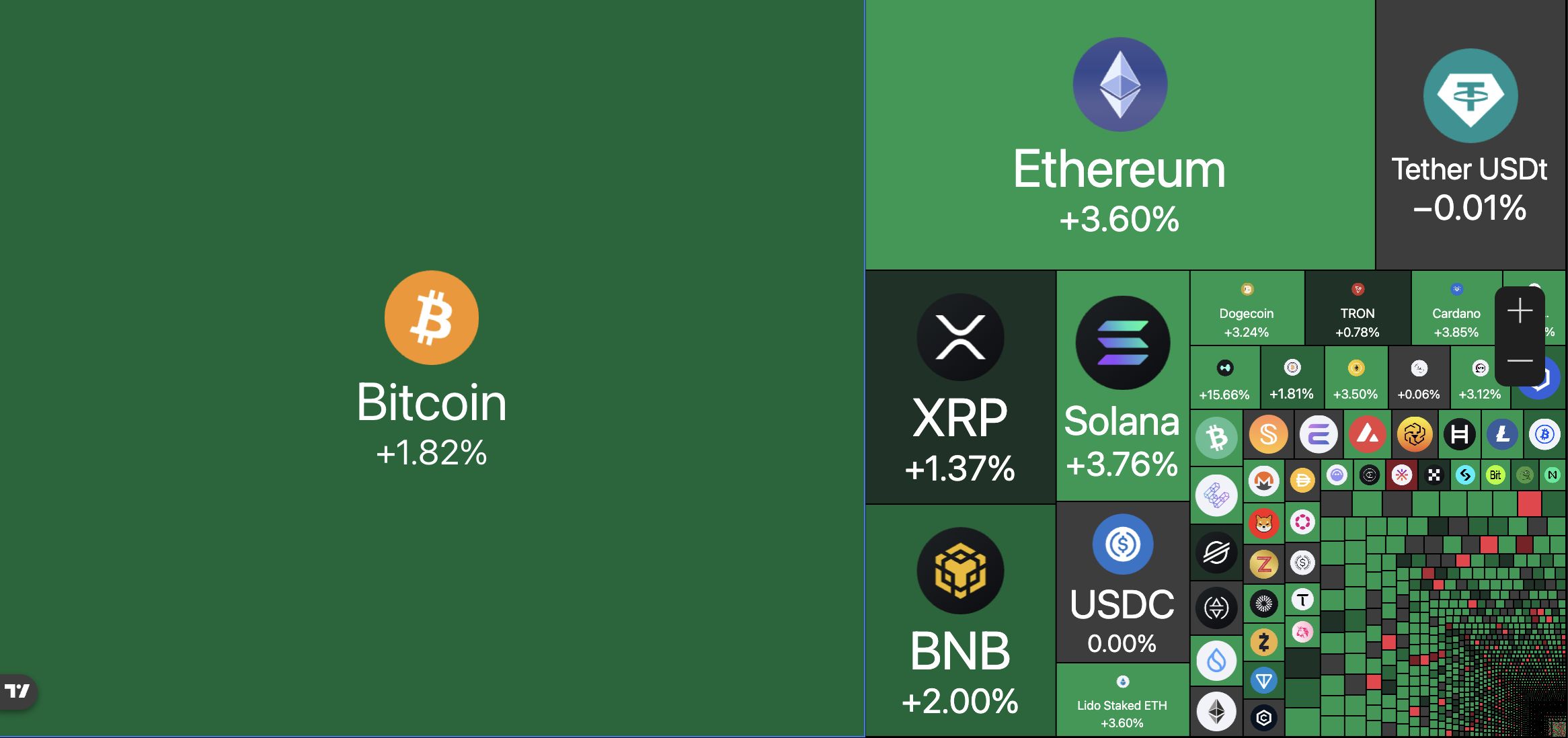If you were to select the most innovative DeFi protocol, who would you nominate?
Pendle would undoubtedly be on the list.
In 2021, Pendle, as the first DeFi protocol to focus on the "interest rate swap" market, single-handedly pioneered a yield trading market worth billions, becoming the absolute leader in the yield trading sector.
And in August 2025, Pendle’s core of daring innovation continued with the launch of Boros, opening up the "funding rate"—a previously overlooked on-chain yield area—bringing funding rate trading, hedging, and arbitrage to the DeFi world for the first time, once again sparking public discussion and a wave of participation.
According to the latest data from Pendle, as of now, Boros has been live for two months, with a cumulative notional trading volume exceeding $950 million, open interest over $61.1 million, more than 11,000 users, and annualized revenue surpassing $730,000.
In just one month, it has already achieved what many projects take years to accomplish. At the same time, many participants excitedly claim: Mastering Boros yield opportunities can be even more lucrative than Meme coins.
So, what is Boros? How does it work? What are its future plans?
Many have noticed that Boros’ brand visuals often feature a giant whale devouring everything, and the word "Boros" in ancient Greek also means "to devour." With the release of Boros 1.0, the launch of the referral program, and the introduction of more markets, Boros’ devouring of the yield world may be officially unfolding through funding rates.
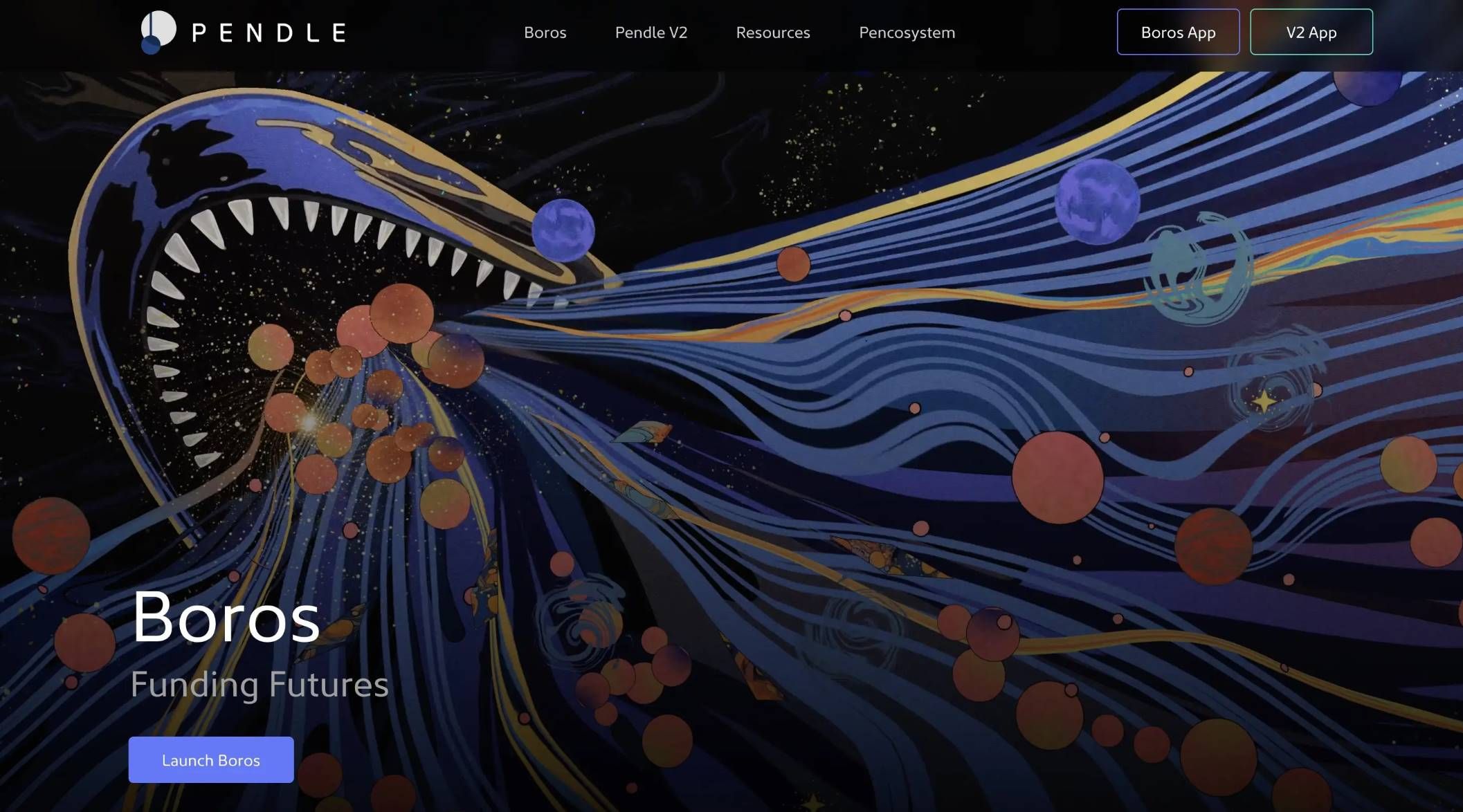
Boros’ First Reputation Shot: Why "Funding Rate"?
As a structured interest rate derivatives platform, Boros currently focuses on funding rates, aiming to turn them into tradable standardized assets.
Most contract users are no strangers to funding rates. It acts like an "invisible hand" in the contract market, balancing perpetual contract prices and spot prices. The logic can be simply understood as:
-
When the funding rate is positive, most people expect prices to rise, longs are dominant, contract prices are higher than spot, and longs must pay funding fees to shorts, curbing excessive market optimism.
-
When the funding rate is negative, most people expect prices to fall, shorts are dominant, contract prices are lower than spot, and shorts must pay funding fees to longs, curbing excessive market pessimism.
As a key to balancing long and short forces, the funding rate is also a crucial indicator of market sentiment.
Before Boros, traders passively accepted the market regulation of funding rates, never imagining that one day funding rates could become a tradable asset.
So, why did Boros choose funding rates as its first product to build reputation?
Large scale, high volatility, and high returns—these characteristics unique to funding rates are the fundamental reasons why Pendle believes in their potential.
-
Large Scale:
The contract market has far surpassed spot in scale, and once the contract market operates, funding rates flow continuously.
According to CoinGlass, in Q2 2025, total perpetual contract trading volume reached $12 trillion, with an average daily volume of about $130 billion. Based on most exchanges’ 0.01%/8-hour settlement rule, the daily funding rate market size easily exceeds tens of millions, and can even surpass 100 millions in extreme conditions.
Better utilization of this massive and stable funding rate market will surely give rise to the next heavyweight financial innovation.
-
High Volatility:
In the spot market, a token’s sharp rise or fall in a day quickly becomes a hot topic, but in the funding rate market, this is the norm.
For example: According to Coinmarketcap, on September 8, 2025, MYX Finance (MYX) surged over 168.00%, topping the list of top 100 crypto tokens by market cap, and quickly became a hot topic. In the tug-of-war between longs and shorts, funding rates themselves are constantly fluctuating, especially for many altcoins, where funding rate volatility can reach four or five times or more. For example, with $TRUMP, some traders paid up to a 20,000% annualized funding rate to maintain long positions.
Taming the wild beast of funding rates not only helps users better formulate trading strategies but also hides huge profit opportunities.
-
High Returns:
The core logic is: volatility creates excellent opportunities for profit.
With volatility comes the opportunity to buy low and sell high. The highly volatile funding rate market can also be an important way for users to capture yield opportunities.
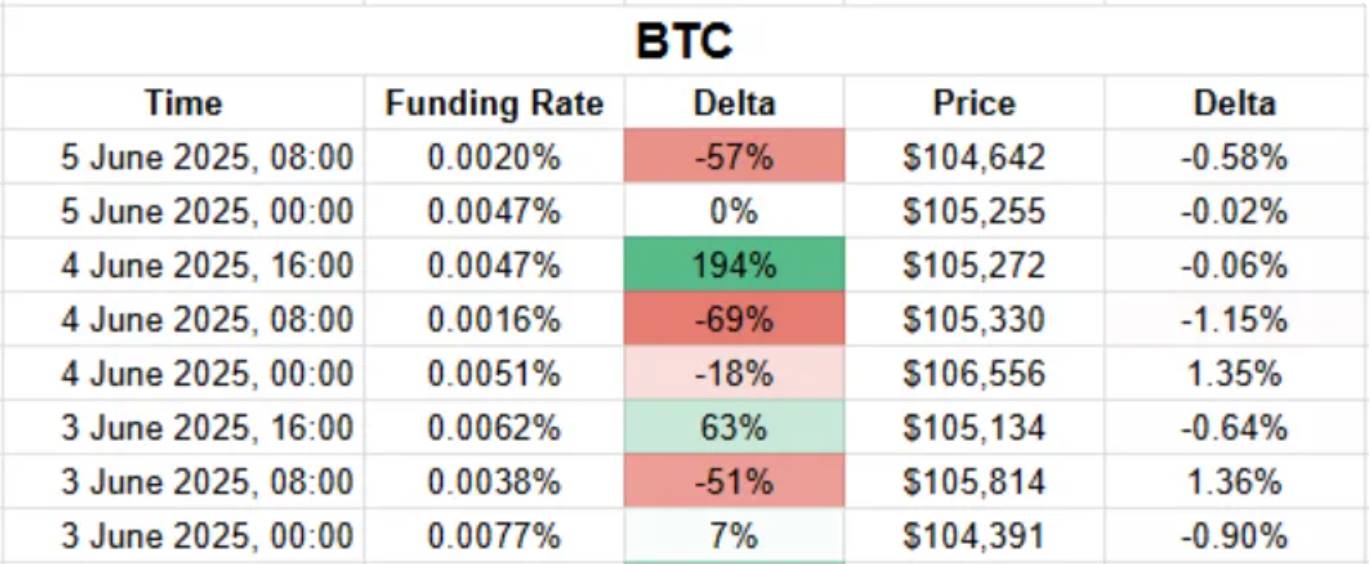
How to turn funding rates into standardized assets for trading, profit, hedging, and arbitrage is a huge test of product design skills.
Betting on Funding Rate Fluctuations: How Does Boros Achieve This?
On the Boros page, Boros has already launched multiple markets for BTC, ETH, and USDT on Binance and Hyperliquid:
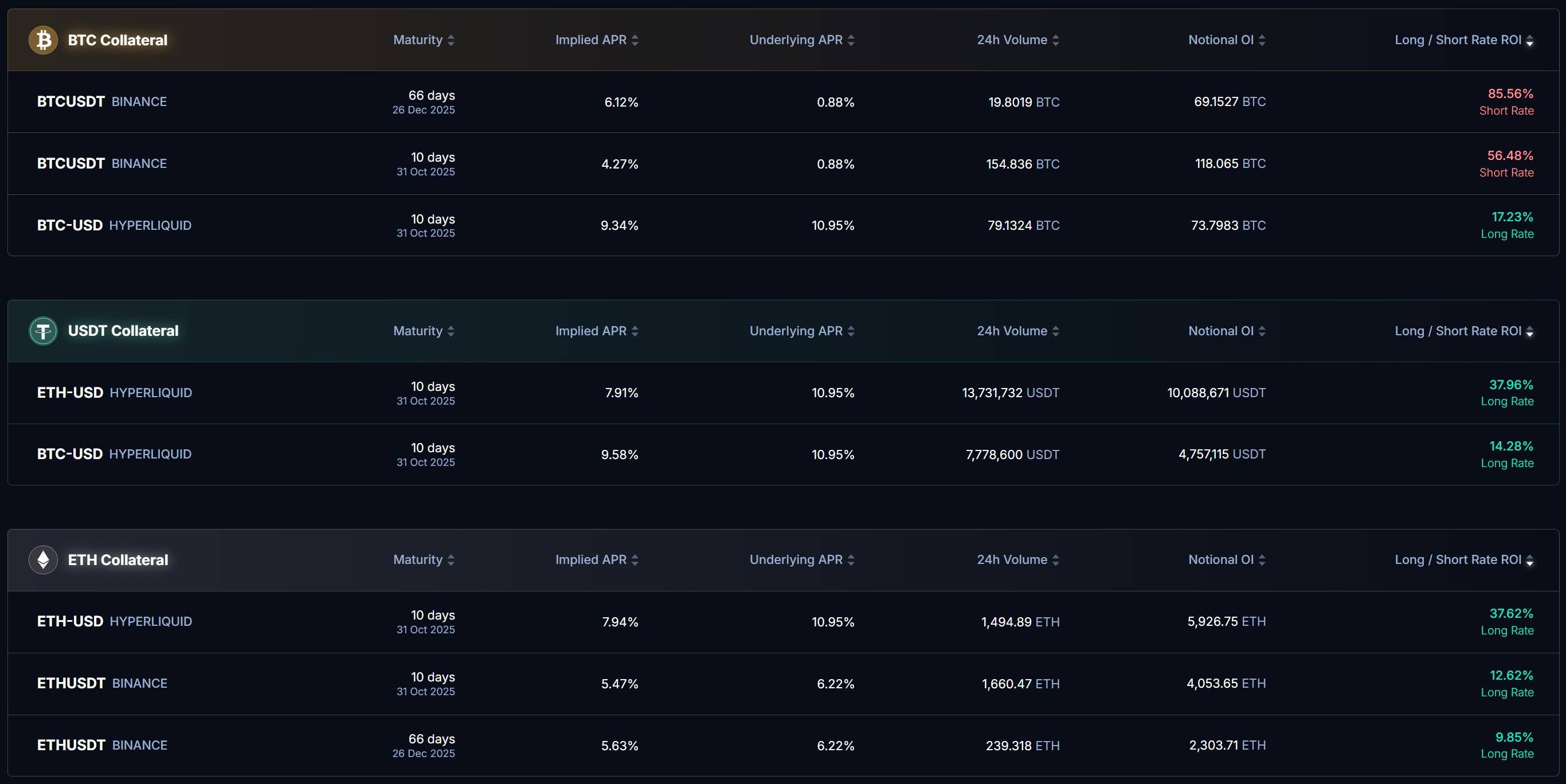
As mentioned above, the funding rate is a key indicator of market sentiment. In other words, if you can accurately sense market sentiment, you can profit from funding rate trading on Boros.
So how do you turn this market prediction into real profits?
The core of Boros is to lock in the current market funding rate as a benchmark and provide users with betting methods: if the future rate rises, those who go long profit; if the future rate falls, those who go short profit.
All of this is achieved through YU.
Users can connect their wallets to deposit, provide collateral, and purchase YU.
YU is the core tool for turning funding rates into standardized assets, representing the right to funding rate income over a future period. At the same time, YU is the smallest trading unit after quantifying the funding rate. For example, for "BTCUSDT Binance," purchasing 1 YU BTCUSDT Binance represents the funding rate income for a 1 BTC position on Binance’s BTCUSDT.
We know that yield = income - cost. The calculation of YU’s yield relies on three core data points: Implied APR, Fixed APR, and Underlying APR.
Buying YU is equivalent to opening a position, which includes two cost components:
On one hand, Implied APR is the rate locked in at the time of opening the position, which can be seen as the price of YU and serves as the fixed annualized rate before maturity. Implied APR is a benchmark for future market funding rate changes, representing the fixed annualized funding rate for a period.
On the other hand, opening a position incurs transaction fees. These fees plus the Implied APR make up the Fixed APR, which is the cost of opening the position.
Once the cost is clear, the next step is to calculate income.
Through YU, a funding rate is fixed, while the actual funding rate on external exchanges is represented by the Underlying APR.
When purchasing YU, there are two options to go long or short on the funding rate:
-
Buy Long YU (long funding rate): During the term, the user pays Implied APR and receives Underlying APR.
-
Buy Short YU (short funding rate): During the term, the user pays Underlying APR and receives Implied APR.
At this point, the profit lies in the difference between income and cost, i.e., the difference between Fixed APR and Underlying APR.
-
When Fixed APR < Underlying APR, i.e., when the floating market rate is higher than the fixed rate, Long YU users profit.
-
When Fixed APR > Underlying APR, i.e., when the floating market rate is higher than the fixed rate, Short YU users profit.
This leads to:
-
Long funding rate: Buy Long YU
-
Short funding rate: Buy Short YU
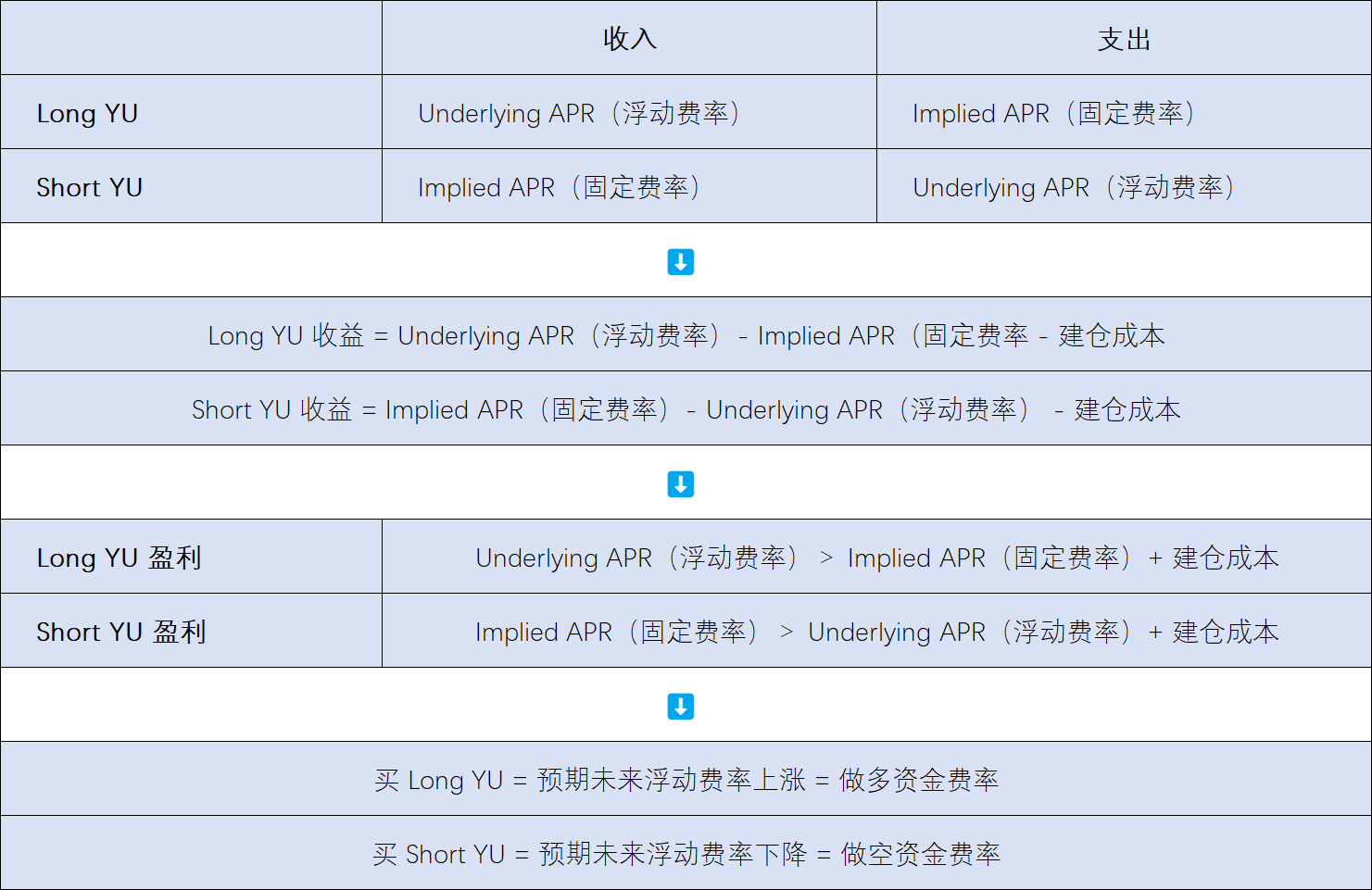
In terms of yield settlement, Boros synchronizes with the settlement cycle of perpetual contract trading platforms.
For example, for the currently available BTCUSDT Binance product: Binance settles its funding rate every 8 hours, and Boros’ BTCUSDT Binance trading pair also settles every 8 hours.
At each settlement, Boros calculates the difference between Fixed APR and Underlying APR for settlement:
-
When Fixed APR < Underlying APR: Short YU collateral is deducted, and the yield is distributed to Long YU users.
-
When Fixed APR > Underlying APR: Long YU collateral is deducted, and the yield is distributed to Short YU users.
We know that YU represents the right to funding rate income over a period, and this right is settled according to exchange rules every 8 hours (or 1 hour). This means that the value of YU decreases with each settlement, and after maturity, as it no longer predicts the rate, YU’s mission is complete and it becomes worthless.
Of course, to unlock greater yield opportunities, Boros also provides up to 3x leverage tools, allowing users to open larger positions with less collateral. However, high leverage also comes with greater liquidation risk, so users need to regularly monitor their health factor and adjust collateral in time to avoid liquidation.
For those familiar with Pendle YT rules, there are indeed many similarities between YT and YU, which can help users better understand YU. However, there are also significant differences in essence, which can be clarified in the table below:
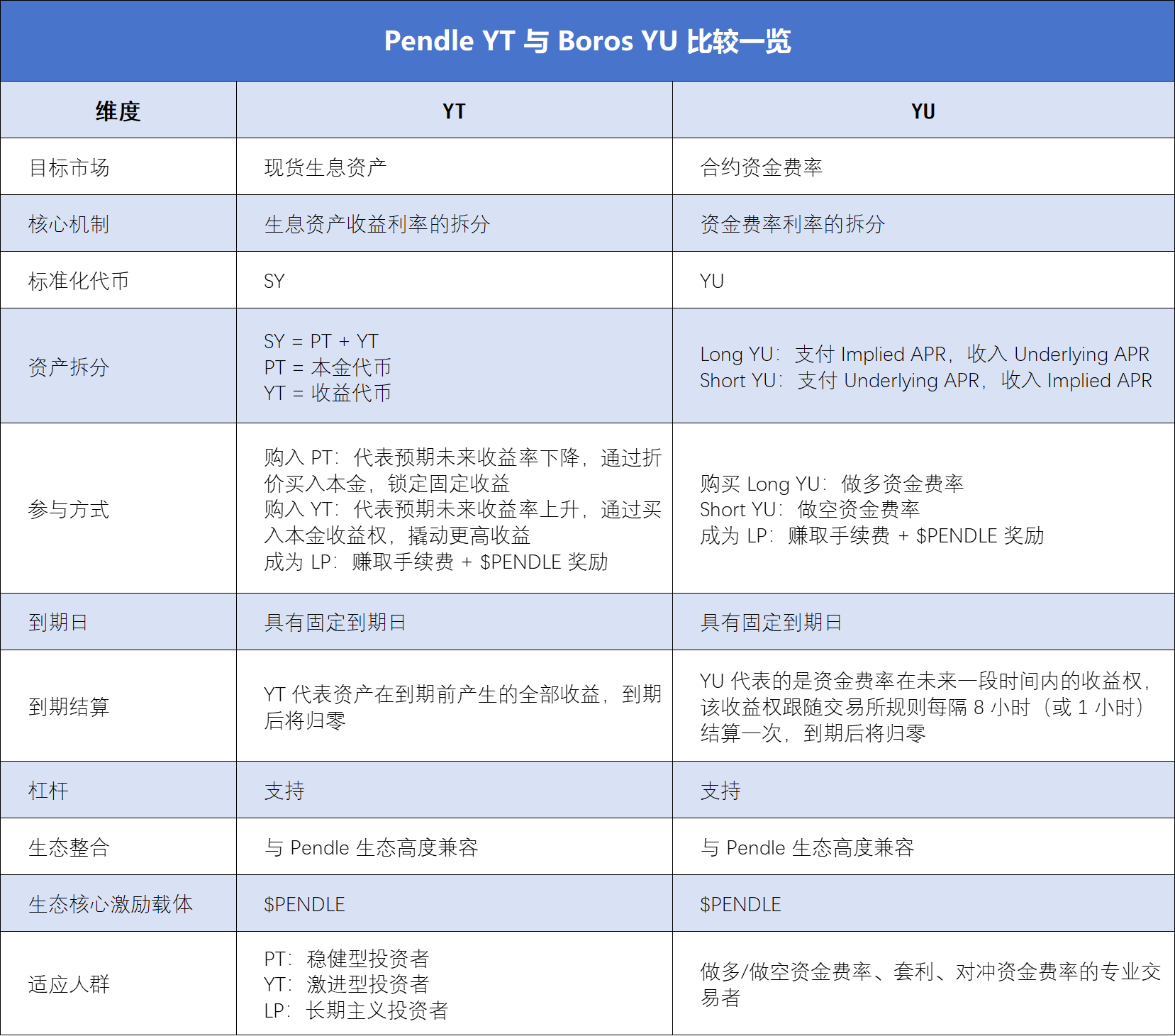
From Hedging to Arbitrage: Boros as a Tool for Cost Reduction and Efficiency
Based on this long/short funding rate mechanism, Boros has, since its launch, sparked spontaneous discussion among contract traders, institutions, and professional DeFi players, actively exploring Boros’ practical uses in many scenarios.
The most direct way to participate is to buy YU and bet on funding rate fluctuations:
By choosing between Long YU and Short YU, users earn the difference between fixed and floating rates. On September 12, 2025, Boros launched the Hyperliquid funding rate trading market. Compared to Binance, Hyperliquid’s funding rate is more volatile, offering users a more intense long/short betting experience.
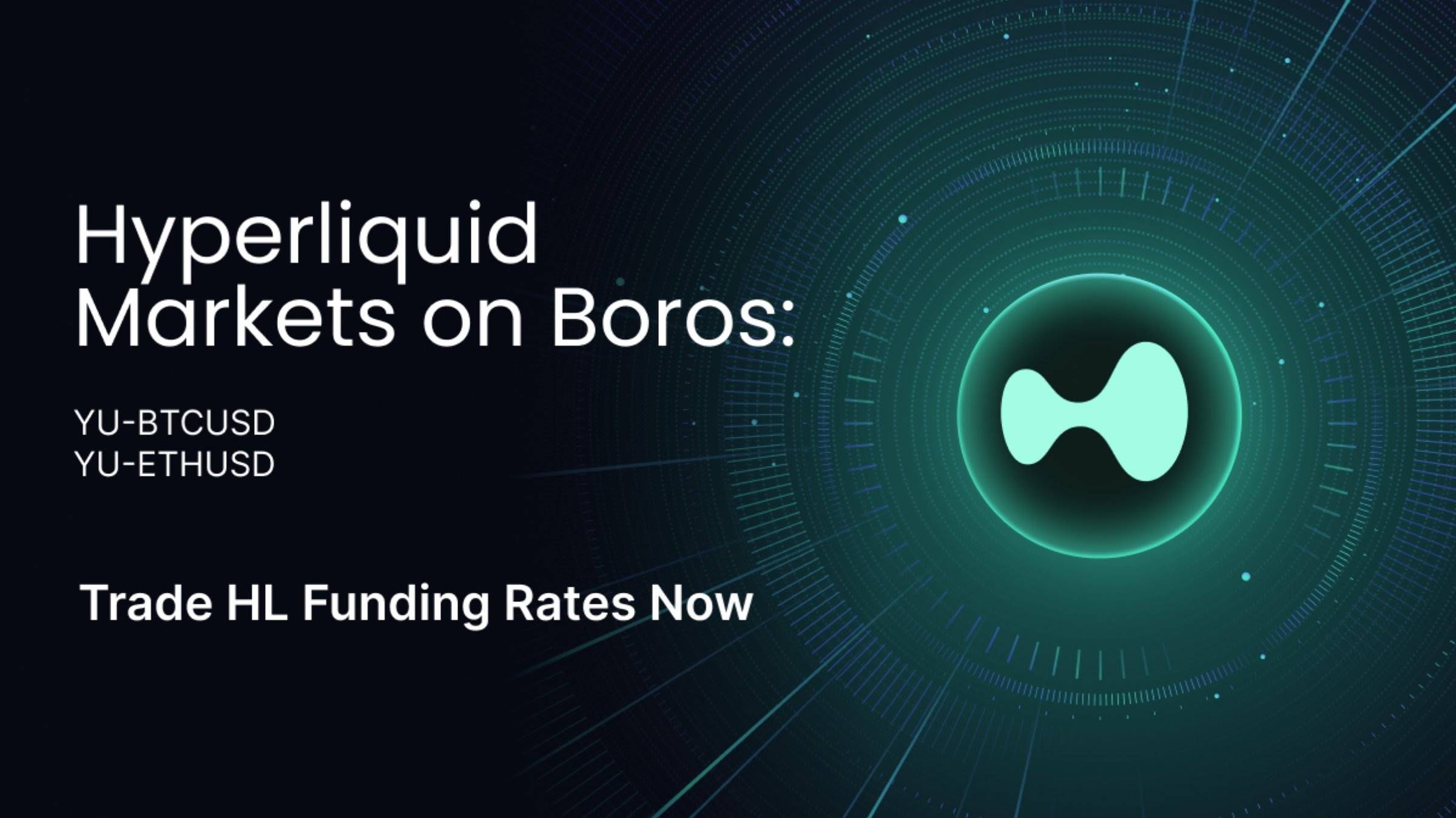
For long-term position holders, Boros’ greater utility lies in funding rate hedging in highly volatile environments: By taking an opposite funding rate strategy on Boros compared to CEX perp positions, users can offset the risk of floating rate volatility, thus locking in costs/yields at a fixed value.
For example, if a user holds a perp long position on CEX and pays a floating rate, they can buy Long YU on Boros to offset the floating rate paid on CEX with the floating rate income from Boros;
Conversely, if a user holds a perp short position on CEX and pays a floating rate, they can buy Short YU on Boros to offset the floating rate paid on CEX with the fixed rate income from Boros.
This makes contract trading risk and cost more controllable, which is very attractive to traders, especially institutional traders. A very intuitive case is Ethena: as a representative of delta-neutral strategies, Ethena’s yield mainly comes from positive funding rates. Therefore, when funding rates fluctuate sharply, Ethena faces huge yield uncertainty, which can even affect the project’s sustainability.
Through Boros protocol’s YU, Ethena can lock in a fixed rate on-chain, achieving predictable returns and improving protocol profitability and efficiency.
Meanwhile, the launch of the Hyperliquid market also unlocks new cross-exchange arbitrage opportunities for users:
The essence of arbitrage is price differences between markets. Currently, among the two major trading platforms supported by Boros, Binance has more institutions and uses an 8-hour settlement cycle, making funding rates relatively stable, while Hyperliquid has more retail users, settles every hour, and has faster capital turnover and more volatile funding rates, creating more space for cross-exchange arbitrage.
In addition to cross-exchange arbitrage, Boros now offers multiple products with different maturities, allowing traders to engage in cross-term arbitrage: if the Implied APR of the earlier-maturing YU is lower than that of the later-maturing YU, it indicates the market expects lower short-term rates and higher long-term rates. One can buy the earlier-maturing YU and sell the later-maturing YU, and vice versa.
Of course, if you’re not good at long/short betting, you can also become an LP:
Boros allows users to become LPs by depositing funds through the Vaults mechanism, providing liquidity for YU trading and earning swap fees and $PENDLE rewards. On the Boros Vaults page, we can see the BTCUSDT Binance Vaults APY is as high as 60.41%.
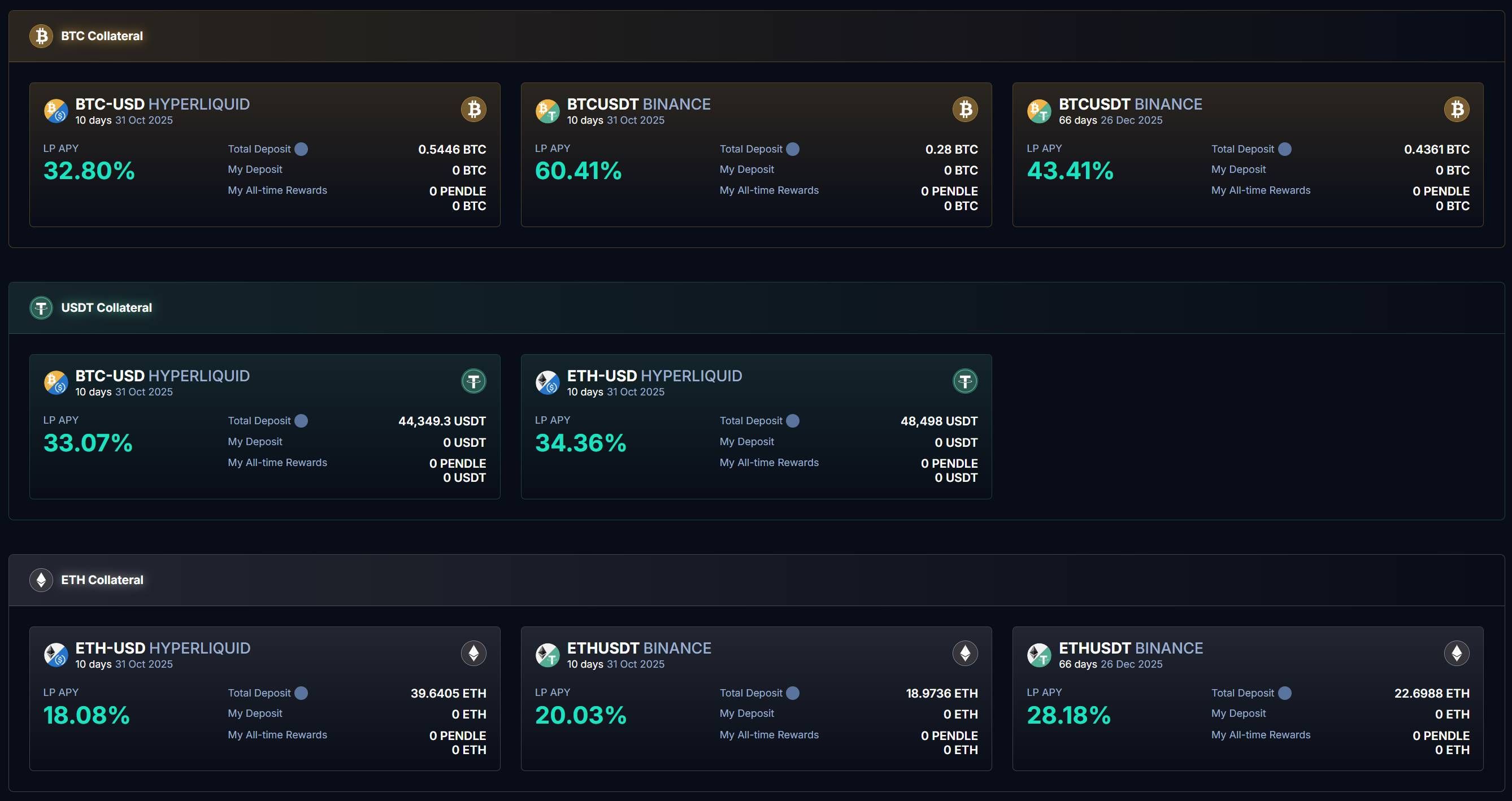
However, it should be noted that since Boros’ Vaults mechanism is similar to Uniswap V2, LP positions are essentially a combination of "YU + collateral" and are affected by Implied APR. Therefore, being an LP is considered a mild long YU position, and when Implied APR drops, users may face the risk of high impermanent loss.
Additionally, due to Boros’ high popularity, Vaults quotas have become more sought after. However, as Boros moves from a soft launch to rapid development, Vaults quotas will gradually increase in the future.
All Resources Return to Pendle: Referral Program Opens Next Rapid Growth Phase
As a core product in Pendle’s 2025 roadmap, Boros not only plays a key role in the Pendle ecosystem but also significantly drives Pendle’s overall development through innovative mechanisms and market expansion.
Pendle’s ultimate vision is to be an "all-in-one yield trading gateway." Boros not only continues Pendle’s innovation in yield tokenization but also pioneers the high-scale, high-volatility funding rate market for the first time, turning CEX and DEX funding rate tokens into standardized assets (YU), expanding Pendle’s ecosystem from on-chain DeFi to off-chain CeFi.
Additionally, when Boros officially announced the launch of version 1.0, it clearly stated that no new tokens would be issued after Boros goes live, and protocol revenue will continue to flow back to $PENDLE and $vePENDLE, further ensuring that $PENDLE will be the ultimate beneficiary of all value created by Pendle V2 and Boros. Meanwhile, on August 6, 2025, upon Boros’ release, $PENDLE surged over 40% in a week, validating the market’s recognition of Boros’ potential.
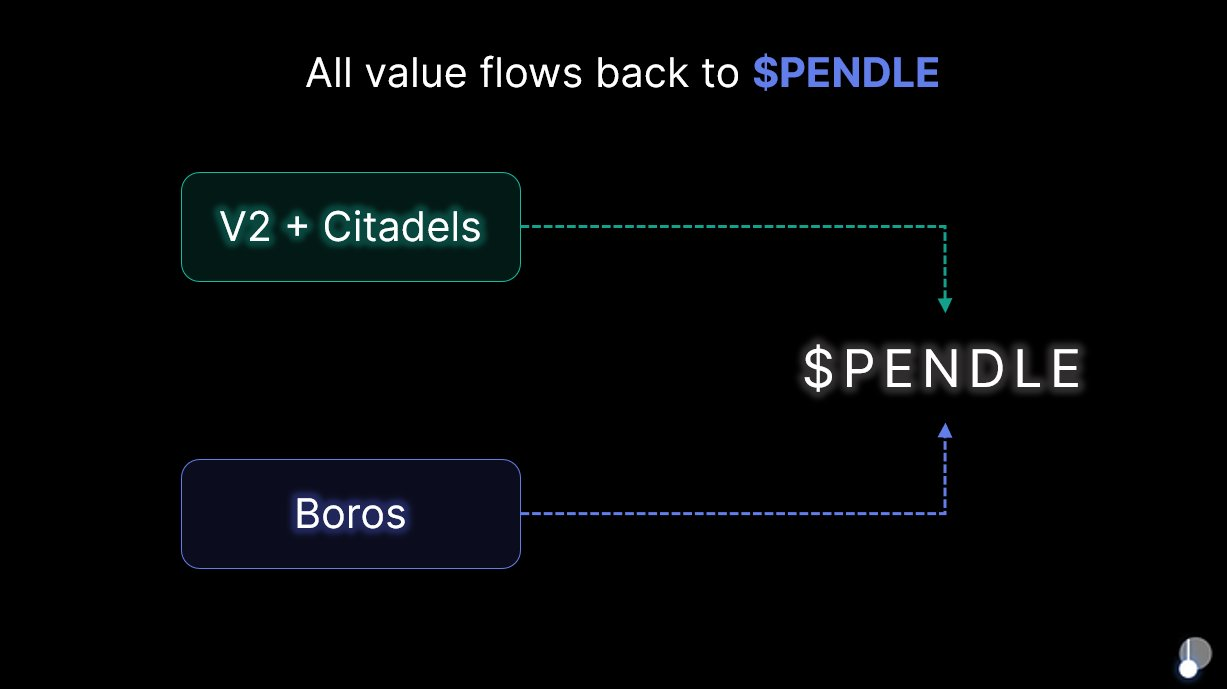
Truly game-changing innovation often comes from rediscovering "long-ignored value." Boros’ focus on funding rates reveals a treasure trove that has long been hidden behind the perpetual contract market—huge in scale but yet to be fully tapped.
Currently, the perpetual contract market has daily open interest exceeding $200 billion, with daily trading volume over $250 billion. Boros achieved nearly $1 billion in notional trading volume and over $730,000 in annualized revenue in just two months, but even so, this only accounts for 0.03% of the market.
In other words, this is a massive market with untapped potential: as the first protocol to focus on funding rate trading, if Boros continues to grow and increases its market share to 3% in the future, that would mean 100x growth potential.
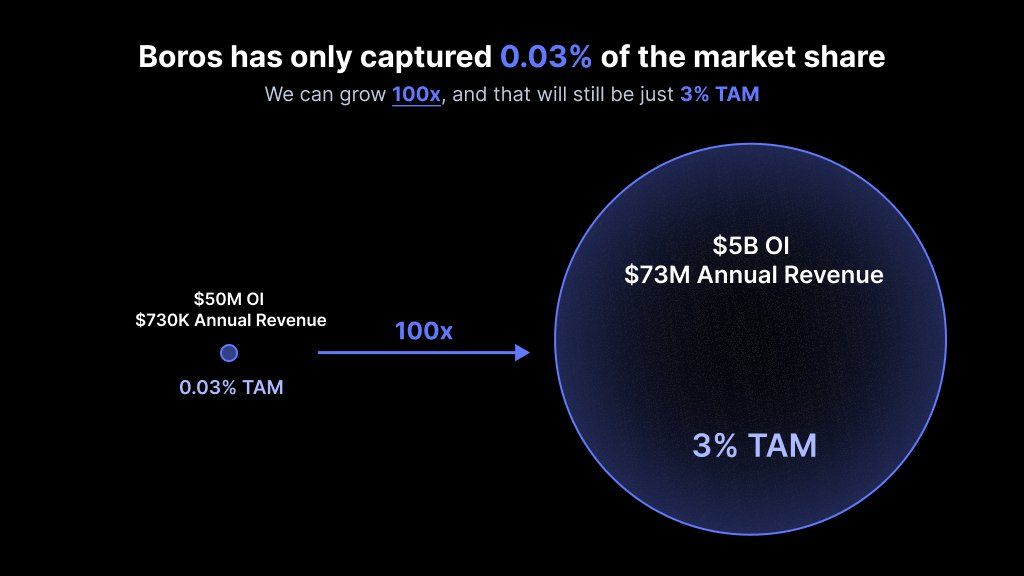
Faced with the huge growth potential of this trillion-dollar track, Boros has already launched several core initiatives to embrace future growth.
On one hand, after more than a month of improvements, testing, and trader feedback, Boros officially launched Boros 1.0 and announced the start of the referral program, marking Boros’ transition from soft launch to full-scale development. After the referral program launches, new addresses with notional trading volume over $100,000 can obtain a referral code. Referrers will receive 20% of the referred user’s settlement fees and 20% of trading fees, while referred users will enjoy a 10% trading fee discount.
Each referral code is valid for one year. If notional trading volume exceeds $1.1 billion during this period, the 10% discount will no longer apply.
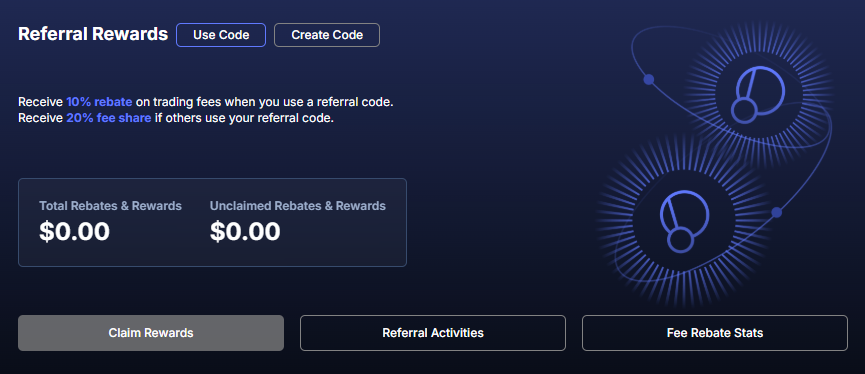
On the other hand, Boros will continue to optimize and improve its functions and products, supporting more assets, more trading platforms, and higher leverage in the future: Boros currently supports BTC and ETH, and will gradually include SOL, BNB, and more assets; it currently supports Binance and Hyperliquid, and will support Bybit, OKX, and more trading platforms in the future; as the market matures, higher leverage will be supported, attracting more users to unlock higher yields at lower costs. Other additional measures include raising the OI cap and increasing vault quotas.
Beyond product optimization, Boros’ scalable framework is even more noteworthy:
Besides funding rates, Boros’ architecture can support any form of yield, including those from DeFi protocols, TradFi, as well as bonds, stocks, and other RWA assets. This means that after conquering the massive funding rate market, Boros will have the opportunity to expand into DeFi, CeFi, TradFi, and more dimensions.
This further aligns with Pendle’s mission: "Where there is yield, there is Pendle." As Pendle’s flagship product for 2025, in the foreseeable future, Pendle will use Boros as a medium to further cover both crypto and traditional financial markets, and, together with the deepening of the Citadels compliant PT plan, rapidly move toward the vision of an "all-in-one yield trading gateway."
Standing at the starting point of this all-encompassing yield devouring journey, as Boros continues to develop, we are witnessing the formation of a super yield platform that covers all yield types and serves all user groups.


